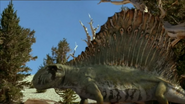Dimetrodon was a pelycosaur, a non-therapsid synapsid genus that flourished during the Permian period, living between 280-265 MYA.
Description
Dimetrodon was an apex predator, among the largest of its day. It grew to up to 3½ meters (11 feet) in length and weighed 250 kilograms (550 lb) (the size of a big cat). The name Dimetrodon means 'two measures of teeth', so named because it had a large skull with two different types of teeth (shearing teeth and sharp canine teeth), unlike reptiles. Dentition showing this differentiation of teeth is called heterodonty. It walked on four side-sprawling legs and had a large tail. Dimetrodon may have moved in a manner similar to present-day lizards. In addition, Dimetrodon was not a dinosaur, despite being often incorrectly classed with them. Rather, it is classified as a pelycosaur. Fossils of Dimetrodon have been found in North America and Europe, as well as significant discovery of Dimetrodon footprints in southern New Mexico by Jerry MacDonald.
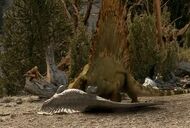
Dimetrodon eating a Edaphosaurus.(Walking with Monsters)
As well as their sheer size and power, Dimetrodon had a killer edge. As a protomammal, they evolved specialized teeth. Incisors shear of chunks of flesh. Serrated canines cut and slice. Humans have inherited these same meat-eating teeth, although we use a smaller version in our mouths today.
There are several species of Dimetrodon, and the information given above refers to the type species only.
Sail
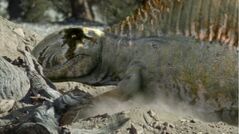
Dimetrodon digging.(Walking with Monsters)
The most distinctive characteristic of Dimetrodon was the spectacular sail on its back (other pelycosaurs such as Edaphosaurus, Ianthasaurus, and Secodontosaurus also have this trait). The sail, which was dense with blood vessels, was probably used to regulate body temperature; the surface area would allow it to warm up or cool off more efficiently. This adaption was important because it would give the animal more time to hunt prey. The sail may also have been used in mating rituals and to warn off other predators. The sail was supported by neural spines, each one sprouting from an individual vertebra. Bramwell and Fellget (1973) calculate that a 200 kg Dimetrodon would heat up from 26 °C to 32° 205 minutes without a sail and in only 80 minutes with a sail. However, some other studies indicate it made a poor heat loss object.
Relationship with Modern Mammals
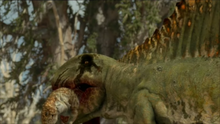
Dimetrodon eating a Seymouria.(Walking with Monsters)
As a non-therapsid synapsid, Dimetrodon was distantly related to modern mammals. Synapsids were the first tetrapods to evolve differentiated (or herodont) teeth. Whereas sauropsids hardly ever chew their food, simply gulping it down, synapsids like Dimetrodon developed teeth to help shear meat into smaller pieces for easier ingestion. These 'two-measure teeth' eventually gave rise to the various kinds of teeth present in modern mammals.
In Walking with... Series
Walking with Monsters
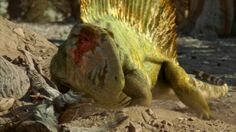
A Dimetrodon with a hurt eye, maybe a survivor of the left fight..(Walking with Monsters)
Reptile's Beginnings
In the second half of this episode, Dimetrodon played a prominent role, as it was depicted living a lifestyle similar to the modern crocodiles. In particular, the baby Dimetrodon were shown hatching with sails, fully independent. In fact, no Dimetrodon eggs have been found and it's entirely possible that the sail, which would be hard to store in an egg, was either absent or not rigid upon hatching.
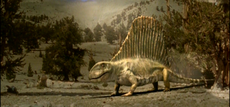
Dimetrodon about to evolve into a Gorgonopsid.(Walking with Monsters)
Furthermore, hatchlings were portrayed sprinting towards trees after hatching in order to escape cannibalistic adults, behaviors based on the modern Komodo Dragon, something that cannot be proven either.

